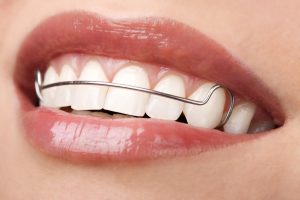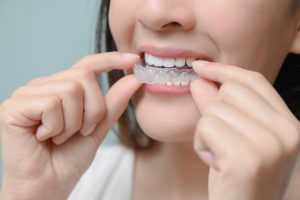Orthodontics is a branch of dentistry that deals with the treatment of congenital and acquired malocclusion, maxillofacial defects and the correction of dental abnormalities. Orthodontic treatment is performed by a dentist specializing in orthodontics.
First orthodontic visit (orthodontic consultation)
During the first visit, the specialist Orthodontist, in order to select an appropriate treatment program, orders the necessary orthodontic diagnostics to plan and evaluate the treatment plan. Before beginning orthodontic treatment, all teeth should be cleaned and healed.
Diagnostyka ortodontyczna
Before an orthodontic appliance is put on, the specialist orthodontist performs the following steps:
- Panoramic X-rays help to assess the condition of the jaw, tooth roots, cavities and the mandibular joint, as well as whether there are any other complications, such as additional teeth;
- Cephalometric X-rays – thanks to them the orthodontist acquires information about the shape of the patient’s bite and the physiology of the growth of the oral cavity. The photos also allow you to carry out the measurements necessary to determine the treatment;
- In doubtful situations, the orthodontist may order CBCT 3D tomography to exclude inflammation, infection and location of impacted teeth;
- Taking two-dimensional impressions;
- Taking spatial impressions;
- Photographic photos of the face and teeth – thanks to them it is possible to register and track changes in the aesthetics of teeth.
Then, the orthodontist selects the appropriate orthodontic appliance, presents the patient with the treatment schedule, discusses its individual stages and the forecast duration of treatment, as well as planned costs.
We invite you to an orthodontic consultation.
Orthodontic treatment of children
Orthodontic consultation is recommended for children after 6 years , when the first permanent teeths appear.
It should be notice that the earlier we diagnose problem the defect and start appropriate treatment, the greater the chance that the patient will enjoy a beautiful and healthy smile.
Additional indications for signing up for an orthodontic consultation are the following symptoms in a child:
- speech disorders,
- disturbing appearance and arrangement of the teeth (the teeth overlap each other),
- mouth breathing – constantly open mouth,
- reverse bite – upper teeth hide behind lower ones,
- disproportionately extended or retracted chin,
- facial asymmetries.
At the Zili Clinic Dental Clinic, we pay special attention to making the first visit to the orthodontist pleasant. In this way, we try to encourage the little patient to continue the treatment and we make sure that our facility has positive associations.
We assure you that the staff at Zili Clinic has many years of experience and visits are absolutely stress-free, even for the youngest patients.
Removable retainers are most often used in the treatment of malocclusion in children.
Orthodontic treatment of youth
The period of adolescence is the optimal time to put on a fixed braces. This is when teenagers begin to care more about their appearance, which is crucial in relationships with their friends. In addition to the positive attitude of adolescents to orthodontic treatment, the medical aspect is also important in this period of life. The age of 12-16 is ideal for the “final” orthodontic treatment. We use the growth jump period to remove serious teeth alignment issues. Due to the fact that the body is at the moment of intensive growth, we can quickly and permanently correct the dentition, and we achieve the effects much easier than in adult patients.
Importantly, the orthodontic appliance itself has long ceased to be a cause for shame. It is fully accepted!
Just like orthodontic treatment has become a normal part of teenage life.
Adult orthodontic treatment
Most often, adults decide to start orthodontic treatment for reasons such as:
- preparation for prosthetic treatment;
- improvement of the current appearance, willingness to become more attractive;
- treatment of malocclusion.
Orthodontic treatment can be undertaken at any age. However, the fact is that in an adult it is much longer and complicated than in children and adolescents. Often, a retainer must be inserted after treatment is completed. In addition, the orthodontist appoints follow-up visits to maintain the desired effect.
Without retainer, very often adult patients see the straight tooth effect disappear and the defect recur. Unfortunately, retention is worn for many years.
Types of orthodontic braces
- Removable braces ( retainer)




Removable braces are used in children who do not have all permanent teeth yet, in order to correct malocclusions and not to deepen the existing ones. The braces should be worn at least several hours a day, then the treatment brings the best results. The removable braces consist of an acrylic plate, a metal arch and metal clamps – children can choose the color of the acrylic plate in the camera. Wearing a removable brace does not hurt, and you may feel a slight feeling of discomfort at times. The parent should remember to regularly visit the attending physician for check-ups with the child in order to adjust and adjust the braces.
The doctor decides about the time of treatment with a removable appliance. - Fixed orthodontic braces
Fixed braces are most often used in adults and older children from 12 years of age or in patients who have all permanent teeth erupted. The doctor decides to put on a fixed appliance after analyzing malocclusions and developing a treatment plan. Fixed braces consist of brackets glued to the outside of the tooth and metal rings glued to the molars.Orthodontic brackets can be made of the following materials:- crystal
- porcelain
- metal

Fixed metal orthodontic appliance (ligature)
Fixed orthodontic appliance made of porcelain (highly aesthetic) 
Invisalign transparent overlays
Invisalign is a system of digitally designed transparent orthodontic overlays that gradually move the teeth in a controlled manner.
- Overlays are worn by the patient 22 hours a day (they are only removed for meals).
- Treatment begins with an oral scan as well as panoramic and cephalometric images, based on which the treatment is planned.
- At the next visit, the doctor presents the patient with a treatment plan along with a digital visualization of its course and final effect.
Advantages of Invisalign orthodontic trays:
- shorter treatment time compared to fixed appliances;
- greater comfort – no metal elements in the mouth that can irritatethe mucosa;
- they are transparent, not very visible, that is highly aesthetic;
- they can be removed at any time when there is a need, for example, for dental treatment or on a wedding day / photo session etc .;
- you can do sports there;
- in the case of missing teeth, they make up for these gaps;
- little failure, durable;
- recommended for patients who travel frequently – check-ups may be less frequent.


